Easy Pantera Songs to Learn on Guitar

Celebrating Dimebag's Timeless Legacy
The year 1966 was a great one — England won the World Cup for the first and probably only time, plus — on August 20, 1966, a boy named Darrell Lance Abbott was born in Dallas, Texas. He grew up to not only be a metal guitarist but also an extraordinary, game-changing one. Better known to us all as simply "Dimebag," Darrell, along with his brother, Vinnie Paul (drums), Philip H. Anselmo (vocals), and Rex Brown (bass), formed a groundbreaking group named Pantera — one of the finest, most influential metal bands of all time. Sadly, neither Dime nor Vinnie are with us anymore.
We figured that since today (August 20, 2019) would have been the late, great guitarist's 53rd birthday, it was only apt to celebrate Dime's remarkable life by looking at the way he played three of his many famous riffs. Picking only three was tough, so we opted for a trio of classics that are often played differently than the way he did — riffs from "A New Level," "Cowboys from Hell," and "Regular People (Conceit)."
The reason we didn't title this piece and the accompanying video "How to Play 3 Famous Pantera Riffs the Right Way" is because the term "wrong" wasn't part of Dime's vernacular, that's why! This quote from him speaks volumes:
"Remember, it's all good, everything goes and there ain't no damned rules."
Amen to that adage. In fact, in his mind, "messing up" often created collateral beauty. To illustrate this truth, here's another great Dime quote:
"When I tried to play something and screwed up, I'd hear some other note that would come into play. Then I started trying different things to find the beauty in it."
Given the above sayings, it should come as no surprise that our subject had a similar stance when it came to scales and modes. Many moons ago, when we were working together on his highly popular monthly column, "Riffer Madness" for Guitar World magazine, Dime told me, "To me there's only one scale you need to know, and that's the chromatic scale!"
"My musical knowledge is pretty limited, scale-wise," he continued, with one of his trademark chuckles. "I know the major scale, the minor scale, the pentatonic blues scale, and the chromatic — that's about it, man! Don't get me wrong, bro, if I can learn a new scale somewhere I'm definitely open to it. I'm not down on scales. It's just that I'm more into riffing and jamming, as opposed to schoolbook, theory reading. Be raw — that's what I always say. I'm always experimenting with new note ideas because in my style there are no rules! Always remember this, and never be afraid to cut loose."
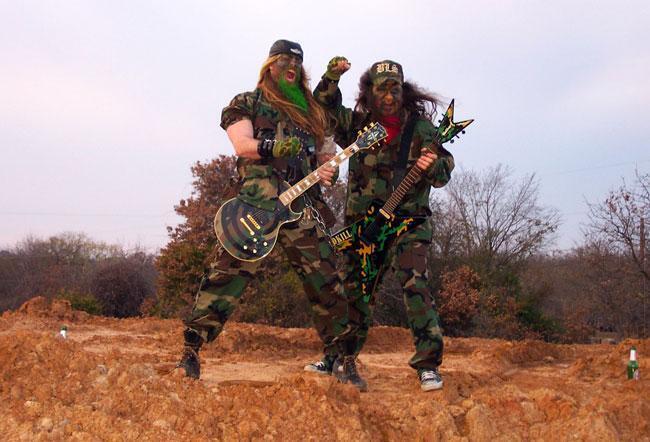
Dime with his great pal Zakk Wylde, during their cover shoot for the March 2003 issue of Guitar World magazine (Photo: Nick Bowcott).
"A New Level" Intro
This crushingly catchy, chromatic climb is often performed on a guitar tuned to Drop D (low to high: D, A, D, G, B, E) and understandably so. It sounds great and is really easy to play with just one-finger, root/fifth power chords on the lowest two strings. That said, that's not how Dime played it. Instead, he played it on a guitar with all six strings tuned a whole step down (low to high: D, G, C, F, A, D).*
*Important Pantera Tuning Note: If you've ever tried to play along to a Pantera CD using a guitar tuned via your faithful, tried-and-tested guitar tuner, you've probably noticed that you're not exactly in tune with the album. Why? I'll let Dime explain: "We're already down something like a quarter-step to begin with," he revealed. "Because of this, when we tune to E, we're really a hair sharper than D#. And when we tune down a whole step to D, we're really nearer to C#, I guess." Mystery solved, back to the riff.
To be honest, playing the "A New Level" intro using 2-fingered root/fifth power chords on a guitar tuned down a whole step isn't as easy as the 1-fingered way in Drop D tuning. That said, there is no way to play the song correctly using Drop D due to the second of the two minor dyads (two notes played at the same time) Dime plays just before the first verse, and elsewhere in the song too. The pesky dyad in question? It's the G minor one that finishes the 3-chord progression shown below.
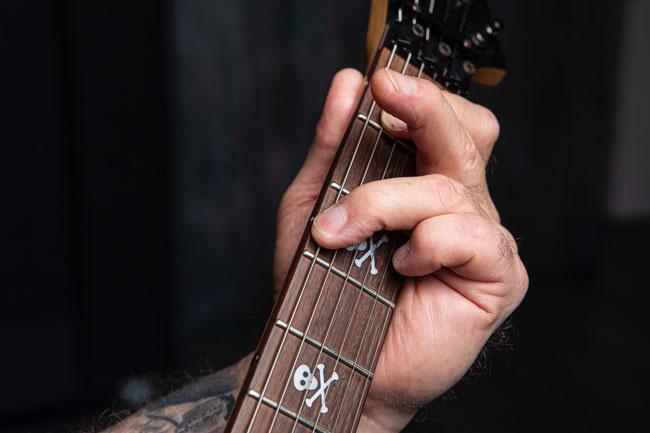
Photo 1: While you can play the first two chords on a Drop D–tuned axe, only one of the two notes that make up the third dyad can be played because the A string is tuned to A, not G. Case closed — Next!!
"Cowboys from Hell" Intro
This is a two-for-the-price-of-one deal, as the main riff is merely a slight but clever variant of the intro riff played an octave lower. "It's a pretty easy riff to play 'cos it's made of one of the first rock scales we all learn — the E minor blues scale," Dime stated.
"The first time you hear this riff is in the song's intro, where I play it an octave higher than I do during the rest of the track," the guitarist continued. "Hearing it an octave higher is kinda like an appetizer — it introduces you to the riff and makes you hungry for more!" Playing it higher first makes the full-blown version sound really heavy when it kicks in. I guess you could say that the intro is the body blow and the main riff is the knock-out punch.
As shown in the accompanying video, the intro riff is often played in the 7th position instead of the 12th, and it sounds just fine, as the notes are exactly the same — providing you play the riff correctly, of course! That said, "the Dime way" is at the 12th, and it definitely sounds a little darker, less bright. Also, as Dime puts it, the thicker strings have the "extra girth" he wants in this riff. Ditto, Tony Iommi's classic "Paranoid" riff: it's often transcribed and played in the 7th position, but the Brit prefers the "darker sound" of playing it in the 12th.

The E minor blues scale notes (E, G, A, Bb, B, D) used in the intro and main "Cowboys from Hell" riffs, shown in the three fretboard positions mentioned (12th, open, and 7th).
"After I'd gotten the intro down, I came up with a heavy variation on it that uses power chords in the open position," Dime told me in a Guitar World series called "How I Wrote a Classic Metal Riff." The reason? "My dad, who was a mean guitar picker, used to say to me, 'learn one thing and then try it in all different ways: up an octave, down an octave, as single notes, as chords — whatever,'" Dime revealed. "So I was just putting some of the old man's advice to good use. I dropped the riff down an octave, threw in some chords, and there it was."
Said power chords — E5 and A5 — are subtle but, er, powerful. I've seen many people play the first eight notes of the main riff as single notes purely on the low E string like this.

The first eight main riff notes as singles on the low E string.
It sounds good, but when played "the Dime way" as shown below, adding those four basic power chords makes all the difference.

The "Dime way"
"Regular People (Conceit)"
One of Dime's favorite ways that "might make a riff more trick'd" was to add in a major or minor power chord (dyad) "here and there." We've already seen the moody impact minor dyads (root/minor third) have just before the verse. In the "Regular People (Conceit)" riff that occurs at 0:24, I've seen a lot of people — including one I respect greatly as he's a staggeringly good player — play the riff using G5, A5, and Bb5 power chords at the end of bars one, two, and three respectively. While using those three root/fifth chords sounds OK, to my ears it's "close but no carrot." Dime used a root/major-third dyad shape (see photo below) for these three chords instead, and this subtle, 1-note change makes all the difference in the world.
How do I know this as a 333% irrefutable truth? Because I was blessed enough to have the man himself show me — and I can't put a price on that! The two photos below show a regular G5 root/fifth power chord and the G major dyad shape Dime used instead.
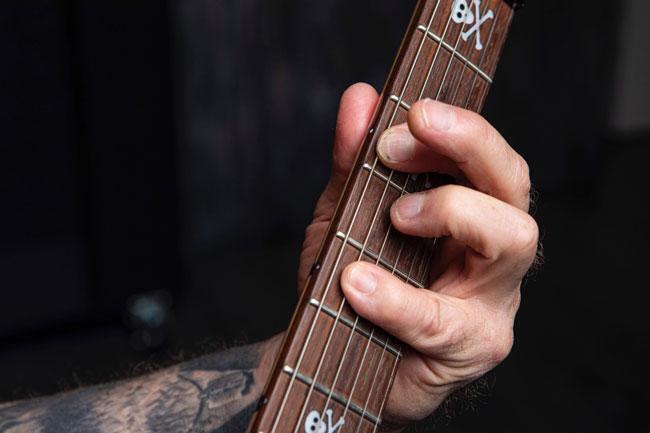
Photo 2: G5 root/fifth power chord
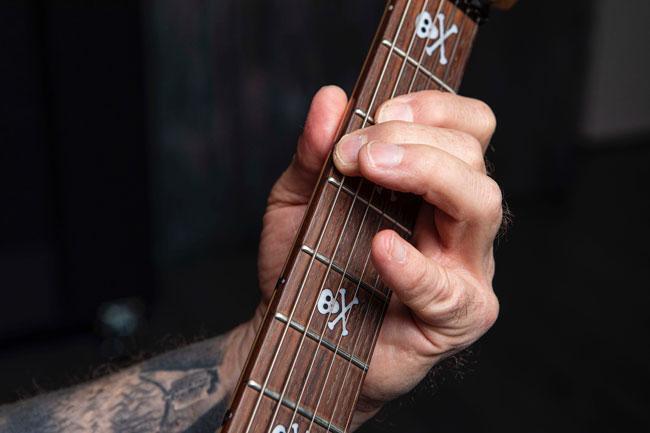
Photo 3: G root/major-third dyad
Conclusion
While what we've just gone over is "the Dime way," always remember that in his world, there was no such thing as "right" or "wrong" when it came to music. So it's only fitting we close this piece with one final snippet of Dimebonic wisdom:
"Remember, it's all good and there ain't no damned rules or boundaries. Make tracks! Leave marks!"
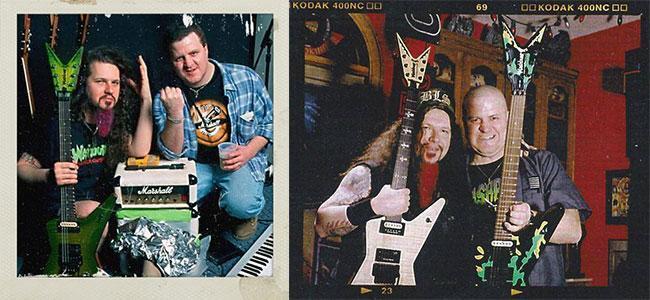
The author enjoying some precious "Dime Time" at the guitarist's legendary "Camp Strapped" Texas home in 1996 and 2002 respectively.
Source: https://www.sweetwater.com/insync/how-to-play-3-famous-pantera-riffs-the-dimebag-way/
0 Response to "Easy Pantera Songs to Learn on Guitar"
Post a Comment